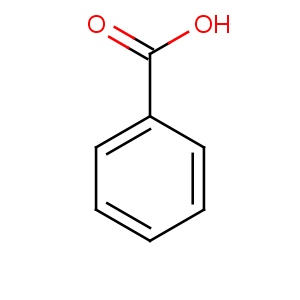Title: Benzoic Acid
CAS Registry Number: 65-85-0
Synonyms: Benzenecarboxylic acid; phenylformic acid; dracylic acid
Molecular Formula: C7H6O2
Molecular Weight: 122.12
Percent Composition: C 68.85%, H 4.95%, O 26.20%
Literature References: Occurs in nature in free and combined forms. Gum benzoin may contain as much as 20%. Most berries contain appreciable amounts (around 0.05%). Excreted mainly as hippuric acid by almost all vertebrates, except fowl. Mfg processes include the air oxidation of toluene, the hydrolysis of benzotrichloride, and the decarboxylation of phthalic anhydride:
Faith, Keyes & Clark's Industrial Chemicals, F. A. Lowenheim, M. K. Moran, Eds. (Wiley-Interscience, New York, 4th ed., 1975) pp 138-144. Lab prepn from benzyl chloride: A. I. Vogel,
Practical Organic Chemistry (Longmans, London, 3rd ed, 1959) p 755; from benzaldehyde: Gattermann-Wieland,
Praxis des Organischen Chemikers (de Gruyter, Berlin, 40th ed, 1961) p 193. Prepn of ultra-pure benzoic acid for use as titrimetric and calorimetric standard: Schwab, Wicher,
J. Res. Natl. Bur. Stand. 25, 747 (1940).
Review: A. E. Williams in
Kirk-Othmer Encyclopedia of Chemical Technology vol. 3 (Wiley-Interscience, New York, 3rd ed., 1978) pp 778-792.
Properties: Monoclinic tablets, plates, leaflets. d 1.321 (also reported as 1.266). mp 122.4°. Begins to sublime at ~100°. bp760 249.2°; bp400 227°; bp200 205.8°; bp100 186.2°; bp60 172.8°; bp40 162.6°; bp20 146.7°; bp10 132.1°. Volatile with steam. Flash pt 121°C. pK (25°) 4.19. pH of satd soln at 25°: 2.8. Soly in water (g/l) at 0° = 1.7; at 10° = 2.1; at 20° = 2.9; at 25° = 3.4; at 30° = 4.2; at 40° = 6.0; at 50° = 9.5; at 60° = 12.0; at 70° = 17.7; at 80° = 27.5; at 90° = 45.5; at 95° = 68.0. Mixtures of excess benzoic acid and water form two liquid phases beginning at 89.7°. The two liquid phases unite at the critical soln temp of 117.2°. Composition of critical mixture: 32.34% benzoic acid, 67.66% water:
see Ward, Cooper,
J. Phys. Chem. 34, 1484 (1930). One gram dissolves in 2.3 ml cold alc, 1.5 ml boiling alc, 4.5 ml chloroform, 3 ml ether, 3 ml acetone, 30 ml carbon tetrachloride, 10 ml benzene, 30 ml carbon disulfide, 23 ml oil of turpentine; also sol in volatile and fixed oils, slightly in petr ether. The soly in water is increased by alkaline substances, such as borax or trisodium phosphate,
see also Sodium Benzoate.
Melting point: mp 122.4°
Boiling point: bp760 249.2°; bp400 227°; bp200 205.8°; bp100 186.2°; bp60 172.8°; bp40 162.6°; bp20 146.7°; bp10 132.1°
Flash point: Flash pt 121°C
pKa: pK (25°) 4.19
Density: d 1.321 (also reported as 1.266)
Derivative Type: Barium salt dihydrate
Synonyms: Barium benzoate
Molecular Formula: C14H10BaO4.2H2O
Molecular Weight: 415.58
Percent Composition: C 40.46%, H 3.40%, Ba 33.04%, O 23.10%
Properties: Nacreous leaflets.
Poisonous! Soluble in about 20 parts water; slightly sol in alc.
Derivative Type: Calcium salt trihydrate
Synonyms: Calcium benzoate
Molecular Formula: C14H10CaO4.3H2O
Molecular Weight: 336.35
Percent Composition: C 49.99%, H 4.79%, Ca 11.92%, O 33.30%
Properties: Orthorhombic crystals or powder. d 1.44. Soluble in 25 parts water; very sol in boiling water.
Density: d 1.44
Derivative Type: Cerium salt trihydrate
Synonyms: Cerous benzoate
Molecular Formula: C21H15CeO6.3H2O
Molecular Weight: 557.50
Percent Composition: C 45.24%, H 3.80%, Ce 25.13%, O 25.83%
Properties: White to reddish-white powder. Sol in hot water or hot alc.
Derivative Type: Copper salt dihydrate
Synonyms: Cupric benzoate
Molecular Formula: C14H10CuO4.2H2O
Molecular Weight: 341.80
Percent Composition: C 49.20%, H 4.13%, Cu 18.59%, O 28.09%
Properties: Light blue, cryst powder. Slightly soluble in cold water, more in hot water; sol in alc or in dil acids with separation of benzoic acid.
Derivative Type: Lead salt dihydrate
Synonyms: Lead benzoate
Molecular Formula: C14H10O4Pb.2H2O
Molecular Weight: 485.46
Percent Composition: C 34.64%, H 2.91%, O 19.77%, Pb 42.68%
Properties: Cryst powder.
Poisonous! Slightly sol in water.
Derivative Type: Manganese salt tetrahydrate
Synonyms: Manganese benzoate
Molecular Formula: C14H10MnO4.4H2O
Molecular Weight: 369.23
Percent Composition: C 45.54%, H 4.91%, Mn 14.88%, O 34.67%
Properties: Pale-red powder. Sol in water, alc. Also occurs with 3H2O.
Derivative Type: Nickel salt trihydrate
Synonyms: Nickel benzoate
Molecular Formula: C14H10NiO4.3H2O
Molecular Weight: 354.97
Percent Composition: C 47.37%, H 4.54%, Ni 16.53%, O 31.55%
Properties: Light-green odorless powder. Slightly sol in water; sol in ammonia; dec by acids.
Derivative Type: Potassium salt trihydrate
Synonyms: Potassium benzoate
Molecular Formula: C7H5KO2.3H2O
Molecular Weight: 214.26
Percent Composition: C 39.24%, H 5.17%, K 18.25%, O 37.34%
Properties: Crystalline powder. Sol in water, alc.
Derivative Type: Silver salt
Synonyms: Silver benzoate
Molecular Formula: C7H5AgO2
Molecular Weight: 228.98
Percent Composition: C 36.72%, H 2.20%, Ag 47.11%, O 13.97%
Properties: Light-sensitive powder. Sol in 385 parts cold water, more sol in hot water; very slightly sol in alc.
Derivative Type: Uranium salt
Synonyms: Uranium benzoate; uranyl benzoate
Molecular Formula: C14H10O6U
Molecular Weight: 512.25
Percent Composition: C 32.83%, H 1.97%, O 18.74%, U 46.47%
Properties: Yellow powder. Slightly sol in water, alc.
CAUTION: Mild irritant to skin, eyes, mucous membranes.
Use: Preserving foods, fats, fruit juices, alkaloidal solns, etc; manuf benzoates and benzoyl compds, dyes; as a mordant in calico printing; for curing tobacco. As standard in volumetric and calorimetric analysis. Pharmaceutic aid (antifungal).
Therap-Cat-Vet: Has been used with salicylic acid as a topical antifungal.

